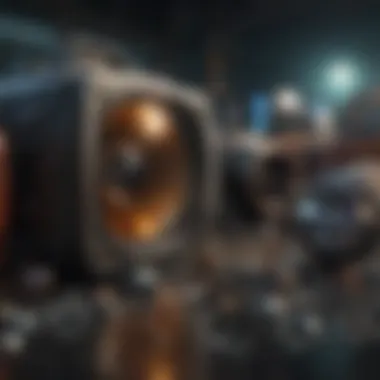Exploring NFTs: Uses, Risks, and Opportunities


Intro
In recent years, the rise of non-fungible tokens (NFTs) has taken the digital world by storm. They are like a digital fingerprint, unique and easily traceable, offering opportunities across various sectors—from art and entertainment to gaming and real estate. However, for those looking to dip their toes into the waters of NFTs, it's vital to understand some key concepts that form the backbone of this innovative space.
The journey into NFTs is not just about buying digital artwork or collecting rare in-game items; it’s about comprehending the mechanisms behind these tokens, recognizing the industry lingo, and navigating the potential risks and rewards involved. From individual artists monetizing their work directly to businesses engaging with blockchain technology, NFTs are reshaping how value is created and exchanged in the digital realm.
As we unpack the potential of NFTs, we’ll dive into the terminology that fuels discussions among enthusiasts and investors alike. By defining core concepts and exploring their practical applications, readers can be better equipped to engage in meaningful conversations about NFTs and make informed decisions.
Definition of Key Terms
Understanding NFTs means knowing some critical terms. Here are a few foundational concepts that serve as stepping stones into the world of non-fungible tokens:
Important Financial Concepts
- Blockchain: A decentralized digital ledger that records transactions across many computers securely. This technology underpins NFTs, ensuring authenticity and ownership.
- Minting: The process of creating a new NFT, which involves converting a digital file into a token on the blockchain.
- Gas Fees: Transaction fees required to conduct operations on the blockchain. This can vary widely based on network congestion.
Industry Jargon and Acronyms
- NFT: Non-Fungible Token, a type of digital asset representing ownership of unique items.
- ERC-721: A standard for NFTs on the Ethereum blockchain, ensuring that each token is unique and not interchangeable.
- DAO: Decentralized Autonomous Organization, a collective that operates through smart contracts with governance often decided by token holders.
Glossary of Terms
Here’s an alphabetical list of additional terms that may come in handy when navigating the NFT landscape:
- Airdrop: A method of distributing tokens for free, usually to raise awareness or reward holders.
- Smart Contract: Self-executing contracts with the agreement directly written into code.
- Whitelisting: Pre-approval for wallet addresses to participate in a token sale, ensuring they can buy or mint NFTs before they're made available to the general public.
User-Friendly Search Functionality
For those eager to familiarize themselves with the ins and outs of NFTs further, consider checking resources like Wikipedia or Britannica. Reddit and Facebook also have communities that actively discuss these evolving topics, perfect for staying updated on trends and insights.
"In a world that is increasingly digital, NFTs represent a tangible connection to assets that can be uniquely owned and traded."
As we progress, this foundational knowledge will equip you to navigate the potential of NFTs with confidence. Understanding these terms is just the beginning; the following sections will delve deeper into practical applications and considerations that impact artists, investors, and businesses in this rapidly evolving landscape.
Understanding NFTs
Understanding non-fungible tokens (NFTs) is critical in today's digital economy. They’re not just a passing fad; they represent a convergence of technology, creativity, and financial opportunity. Grasping the essence of NFTs enables artists, investors, marketers, and enthusiasts to make informed decisions. The absence of clear understanding can lead to missed opportunities or costly mistakes.
Definition and Characteristics
Non-fungible tokens, as the name implies, are unique digital assets that stand apart from each other. Unlike cryptocurrencies such as Bitcoin or Ethereum that are interchangeable, an NFT is irreplaceable. Each token carries specific information that establishes its identity and ownership, making it distinct.
Some characteristics that define NFTs include:
- Unique Ownership: Each NFT has a unique identifier that distinguishes it from others in the blockchain. This is akin to owning a one-of-a-kind piece of art.
- Indivisibility: Unlike cryptocurrencies, these tokens cannot be divided into smaller units. If you own an NFT, you own it whole.
- Transferability: NFTs can be traded or sold on various platforms. This feature creates a vibrant marketplace, allowing owners to make profits.
- Smart Contracts: Embedded in the NFT are smart contracts that automatically execute actions when certain conditions are met. For instance, an artist can ensure they receive a percentage each time their work is resold, which doesn't occur in traditional art markets.
Technological Foundations of NFTs
To properly appreciate NFTs, one must delve into the technology that empowers them. NFTs operate on blockchain technology, a decentralized and distributed ledger. This technology is crucial for ensuring security, transparency, and authenticity of NFTs.
Key aspects of the technology behind NFTs include:
- Blockchain Networks: Ethereum is primarily known for hosting NFTs, but other networks like Binance Smart Chain and Solana are also gaining traction. Each platform has its own protocols and standards.
- Interoperability: Many NFTs are created using standards like ERC-721 or ERC-1155 on the Ethereum blockchain. These standards dictate how NFTs function and interact with other smart contracts.
- Metadata: Each NFT carries metadata with details about its content and ownership, which remains invariant and secure on the blockchain. This ensures that the original creator and authenticity of the piece can always be tracked.
The Role of Blockchain in NFTs
Blockchain serves as the backbone of the NFT ecosystem, offering a secure and transparent framework for transactions. The decentralized nature of blockchain means that no single authority can alter or control it, mitigating risks of counterfeiting or fraud.
The role of blockchain in NFTs can be categorized as follows:
- Ownership Verification: Blockchain creates an immutable record of ownership. This means buyers can verify the authenticity of their digital assets effortlessly before making any transactions, thereby enhancing trust in the market.
- Decentralization: Since NFTs are stored on a decentralized network, they resist censorship or manipulation. This allows creators and investors to engage freely without interference.
- Innovative Business Models: The blockchain model lays the groundwork for new avenues of monetization and engagement. For instance, musicians can sell music directly to fans through NFTs without needing traditional intermediaries.
NFTs are reshaping industries, sparking new conversations about digital ownership and value creation. They’re a doorway to exploring innovative economic models, community building, and experiencing the digital arts in ways unimagined.
"In this ever-evolving landscape, a solid grasp of NFTs and their operational framework will equip you to navigate the complexities of the digital art economy effectively."
The understanding of NFTs is not merely academic; it has practical implications for anyone looking to leverage this technology for investment, creative endeavors, or community engagement.
Creating and Selling NFTs
Creating and selling NFTs represents a significant turning point in the digital marketplace. This section highlights the processes and strategies that make up this frontier, which serves artists, innovative businesses, and savvy investors alike. When artists create NFTs, they are not merely digitizing their work; they are redefining ownership and authenticity in a realm where every pixel can be valuable. For businesses, NFTs offer a unique method of engaging customers, offering them something tangible in an increasingly digital world. Investors are also finding a goldmine of opportunities by recognizing the potential for high value, appreciating the rarity that NFTs offer within the crypto space. The importance of this section cannot be overstated—those looking to tap into this burgeoning market must understand how to effectively create and sell these assets.


Steps to Mint an NFT
Minting an NFT is akin to creating a digital fingerprint of an asset that verifies its uniqueness and ownership on the blockchain. The process, while appearing straightforward, requires careful steps to ensure the NFT is correctly created and deployed. Here’s how to do it:
- Choose Your Digital Asset: Start by selecting the digital item you wish to mint. This could be artwork, music, collectibles, or even a tweet. It's essential that the item can stand alone in terms of value and significance.
- Create a Digital Wallet: A digital wallet will be your portal to the NFT world, allowing you to store your NFTs and cryptocurrencies. Wallets such as MetaMask or Coinbase Wallet are popular choices.
- Select a Blockchain: Ethereum is the go-to blockchain for NFTs, but alternatives like Binance Smart Chain or Flow can be viable depending on your needs.
- Choose a Marketplace: With several marketplaces available, pick one that aligns well with your creation. This will be covered in detail in the next section.
- Mint Your NFT: Upload your digital asset to the chosen marketplace, fill out the necessary details such as title and description, and proceed with the minting process. This usually requires a transaction fee known as "gas fees."
- List for Sale: Once your NFT is minted, you can list it for sale. Here, decide whether you want to set a fixed price or opt for an auction-style sale.
Selecting the Right Marketplace
Choosing the right marketplace is a pivotal step for anyone venturing into NFTs. Each platform varies in terms of user experience, fees, audience reach, and specific features. Three of the most prominent marketplaces are OpenSea, Rarible, and Foundation.
OpenSea
OpenSea stands out as one of the largest and most diverse NFT marketplaces available today. Its contribution is significant given its extensive collection of digital items across various categories, from art and music to virtual real estate. One of OpenSea’s key characteristics is its user-friendliness, allowing creators to mint NFTs without any technical know-how.
Another unique feature is the ability to run auctions and set up royalties for future sales, making it a beneficial choice for artists aiming to generate ongoing revenue from their work. The downside, however, can be the high gas fees associated with Ethereum transactions, which may deter some new users.
Rarible
Rarible positions itself as a community-driven platform, allowing users to actively participate in the governance of the marketplace through its $RARI token. This is a standout aspect of Rarible, as it empowers users and ensures they have a voice in the ecosystem.
The platform is known for its lower fees compared to OpenSea, making it particularly attractive for creators who are just starting. Additionally, the ability to create and sell both single pieces and collections enhances its versatility. A downside is that, due to its open nature, the quality control on artworks can vary greatly.
Foundation
Foundation is tailored more for artists, emphasizing high-quality, curated content. This auction-based platform is selective about the creators it allows to join, fostering a more exclusive and premium environment. A key characteristic of Foundation is its focus on helping artists maintain a connection with collectors, through features such as personalized interactions and limited-time drops.
Innovatively, it also facilitates artists to earn royalties on secondary sales, which can be quite rewarding. However, one downside to Foundation is the initial requirement for an invitation, which can limit access for newcomers.
Pricing Strategies for NFTs
Pricing NFTs can be a daunting task, especially when the market is so volatile and the values can swing dramatically. Here are some key strategies to consider:
- Value Assessment: Look at comparable NFTs in the market to gauge a fair price based on trends, demand, and uniqueness.
- Perceived Value: Consider factors such as the creator’s reputation and the artwork’s emotional impact, as they can greatly affect how potential buyers perceive value.
- Auction vs. Fixed Price: Deciding between an auction format or a fixed price can significantly influence the response. Auctions can generate excitement and competition, while fixed prices can attract those who prefer straightforward transactions.
Using these strategies effectively requires careful thought and ongoing market analysis to adapt to changing conditions.
NFTs in the Art World
As the digital landscape evolves, the intersection of art and technology becomes more pronounced; non-fungible tokens (NFTs) have emerged as a significant trend reshaping how art is created, sold, and owned. In this section, we will delve into the various roles that NFTs play in the art world, focusing on their capacity to empower artists, their impact on traditional art sales, and important legal aspects surrounding these digital assets.
Empowering Artists through NFTs
NFTs provide artists with an unprecedented platform to showcase and monetize their work directly, circumventing traditional gatekeepers like galleries and auction houses. This direct-to-collector model allows for a more significant share of sales revenue to remain with the creators. For instance, an artist who sells their digital artwork as an NFT can establish the initial price without being constrained by a gallery's commissions.
By leveraging blockchain technology, artists gain not only financial empowerment but also enhanced control over their creations. Each sale can be programed to provide the original artist with royalties on future transactions. This means that as an artwork increases in value, the creator continues to benefit financially, a feature not typically found in the conventional art market.
"The democratization of art sales through NFTs allows artists to flourish without the pressure of corporate interests dictating their worth."
Furthermore, artists can experiment with new forms of expression. Digital mediums no longer carry the stigma of inferiority; instead, they have become recognized in their own right. NFTs have breathed new life into various art forms, from animation to interactive installations, making creativity boundless.
Impact on Traditional Art Sales
The rise of NFTs has sparked considerable debate regarding their influence on traditional art sales mechanisms. Many galleries and collectors are starting to adapt, recognizing that NFTs can coexist with physical art pieces as part of a comprehensive collection. This shift isn’t without resistance; however, it prompts the art world to reconsider its foundational practices.
For collectors, the introduction of NFTs means diversifying their portfolios with unique digital assets that carry intrinsic and speculative value. While some argue that NFT prices are inflated, others see potential for long-term investment.
Nonetheless, established art institutions must navigate the complexities of valuing digital art. Unlike traditional artworks, which can be appraised based on historical significance and aesthetic criteria, NFTs challenge traditional valuation methods. The market’s volatility further complicates this landscape, making the fusion of physical and digital art a nuanced journey for buyers and sellers alike.
In recent reports, sales figures for digital art via NFTs have been staggering, indicating a clear market demand. Yet how does this affect the brick-and-mortar art world? Moving forward, it may require a balance—an appeal to both traditional collectors and new, tech-savvy buyers eager to embrace digitally-verified ownership.
Legal Considerations
The advent of NFTs introduces a myriad of legal considerations that both artists and collectors must navigate. Ownership in the digital space does not automatically confer copyright; thus, understanding intellectual property rights is crucial for anyone participating in the NFT ecosystem. When an artist mints an NFT, they need to determine what rights they are transferring. Is it just access to the artwork, or does it include the copyright for reproduction or derivative works?
Contract clarity is imperative. Many NFT platforms provide templates for such agreements, but they may lack specificity tailored to individual cases. Artists should seek legal counsel to verify that their interests are protected, especially in cases where third parties may exploit their work without due credit or compensation.
Moreover, the question of jurisdiction can complicate matters since NFTs operate on a global scale. Different countries have varying regulations regarding digital assets, which can lead to confusion when disputes arise. As the NFT space continues to expand, staying informed of ongoing developments and potential regulations will be critical for both artists and collectors.
As you reflect on the intersections between art, technology, and commerce, consider the possibilities that lie ahead in the NFT landscape.
Investing in NFTs


Investing in NFTs has emerged as a fascinating avenue for financial enthusiasts, capturing the attention of individual investors looking for new opportunities. The appeal isn't just about owning unique digital assets; it extends to the myriad applications and potential returns associated with these tokens.
As the market for NFTs continues to evolve, understanding the dynamics at play is crucial for anyone considering entering this space. Buying and selling NFTs can transform how individuals look at asset ownership and investment diversification. When done right, investing in NFTs can yield significant rewards, but it also comes with its share of complexities and risks. Recognizing these factors can help prospective investors make informed decisions.
Market Trends and Insights
The landscape of NFTs is continuously shifting, influenced by technological advancements, market forces, and consumer demand. According to recent reports, the market has seen exponential growth, with some NFTs selling for astonishing sums. For instance, digital artwork that was initially acquired for a few hundred dollars may fetch millions at auction. This history of skyrocketing prices has lured many into the NFT investing fray, suggesting that informed projections about future trends can serve as a solid foundation for strategic investments.
Several trends have emerged:
- Expanding Market Segments: Beyond art, sectors like gaming and entertainment are increasingly incorporating NFTs into their ecosystems, creating new avenues for investment.
- Collaborations and Partnerships: More traditional brands are entering the NFT space, which adds credibility and can influence market behaviors by attracting mainstream collectors.
- Innovations in Technology: Platforms and blockchains are improving to offer more functionalities and secure transactions, which can enhance investor confidence.
Keeping an eye on these trends can provide insights into potential areas for profitable investment, ensuring that investors do not miss out on emerging opportunities.
Evaluating NFT Value
Determining the value of an NFT is not straightforward; it can be influenced by various factors beyond just market price. Aspects like scarcity, provenance, and the artist’s reputation play significant roles. An NFT with a compelling backstory that captures the imagination may carry a heftier price tag than one that lacks narrative depth, regardless of artistic merit. Here are several considerations to keep in mind:
- Rarity and Scarcity: Limited edition pieces typically hold more value than mass-produced ones.
- Cultural Significance: NFTs that resonate with current trends or cultural phenomena may see increased demand.
- Transaction History: The auction price history of an NFT can serve as a reference point for potential investors.
Investors should approach NFT valuations with a combination of art appreciation and market analytics; this duality will allow for more balanced investment decisions.
Risks and Rewards of NFT Investments
As with any investment, there are inherent risks associated with NFTs. However, understanding these risks can place investors in a better position to reap the rewards. Here are some critical aspects to consider:
Rewards:
- Potential for High Returns: Many investors have struck gold by purchasing NFTs early and selling them at dramatically higher prices.
- Portfolio Diversification: Including NFTs in an investment portfolio may reduce overall risk by diversifying asset types.
Risks:
- Market Volatility: The NFT market can be highly speculative, with valuations swinging wildly from one week to the next.
- Legal and Regulatory Uncertainty: As the field grows, so does scrutiny, which could lead to regulatory changes that affect the value of NFTs.
Ultimately, potential investors must weigh these risks against the rewards, developing a nuanced understanding of their own risk tolerance. In doing so, they can navigate the world of NFTs with greater confidence and insight.
NFTs in Gaming
The incorporation of NFTs in the gaming industry marks a significant shift in both the mechanics of gameplay and the way players engage with their virtual worlds. Gamers are no longer just passive participants; they can own, trade, and harvest real value from their digital experiences. As the gaming landscape continues to evolve, NFTs provide unique opportunities and challenges, particularly for developers and players alike.
Integrating NFTs into Game Mechanics
The infusion of NFTs into game mechanics is akin to adding rocket fuel to a regular engine. It enhances not just the gaming experience but also acts as a revenue stream and a means for deeper engagement. Through NFTs, players can possess unique in-game items that hold value beyond the confines of the game itself. For instance, items like skins, weapons, or even characters can be minted as NFTs, giving players true ownership.
- Unique Ownership: Each NFT represents a one-of-a-kind asset, which means players can buy, sell, or trade items in a way that was impossible before.
- Interoperability: Players may transfer their NFTs across multiple platforms or games, creating a more unified gaming experience. Imagine a sword from RPG A being wielded in MMORPG B; it adds layers of depth to gameplay.
- Game Economy: In-game currencies may also transform into NFTs, allowing players to invest in their digital footprint, similar to stocks in the financial market.
Integrating NFTs needs careful thought and balancing, as incorporating them carelessly can lead to player dissatisfaction. Developers must emphasize player experience while also considering potential market fluctuations. This calls for a symbiotic relationship between developers and gamers to create a rich ecosystem.
Ownership and Trade in Virtual Worlds
Imagine you might step into your favorite online game, glance at a virtual item in your inventory, and know that it's not just some code buried in a server but rather a valuable asset you own. NFTs turn that wish into reality. When players collect or earn in-game assets as NFTs, they gain actual ownership, which has enormous implications.
- Empowered Players: Ownership lets players leverage their time and resources, leading to a more vibrant secondary market.
- Trade Opportunities: Players can exchange NFTs through various platforms or peer-to-peer marketplaces, akin to stock exchanges where traders engage in lively bargaining.
- Rare Discoveries: Just like digging through old attic boxes may reveal hidden treasures, discovering rare NFTs can be exhilarating—and they often carry premium values in trades.
Ownership creates a culture of trading that can even mirror real-world economic systems. Players get to negotiate, barter, and even speculate, which impacts how games are played and marketed. This dynamic can lead to exhilarating interactions and a deeper community bond.
"The rise of NFTs in gaming is not just a passing trend; it��’s a revolution that redefines ownership and value in the digital age."
NFTs in Entertainment and Media
The world of entertainment and media is undergoing a transformative shift, with non-fungible tokens (NFTs) leading the charge. These digital assets are altering how we perceive ownership and value in creative works. By decentralizing control from traditional gatekeepers, NFTs bring forth opportunities for artists, musicians, filmmakers, and creators to directly monetize their content while engaging their audience on a more personal level. The advantages are manifold, spanning enhanced revenue streams, new forms of engagement, and the democratization of content distribution.
Case Studies of Successful Projects
Several landmark projects in the entertainment sector showcase the potential of NFTs. For instance, the famous musician Kings of Leon recently became the first band to issue an album as an NFT. By doing so, they didn't just sell digital music; they provided exclusive perks, including front-row concert seats, ensuring fans holding these tokens felt valued and part of an exclusive club.
Similarly, the digital artist Beeple captured global attention when he sold an NFT artwork for a staggering $69 million at a Christie's auction. His success isn't an isolated case; it signifies a broader shift in how digital art is perceived and valued. Artists now have a platform to bypass traditional galleries and auction houses, taking control of the narrative around their work.
These case studies position NFTs not merely as novelties but as pivotal tools for creating new monetization channels in the entertainment sphere.
"The rise of NFTs reflects a significant cultural and economic shift, in which creators reclaim agency over their work."


Distribution Rights and Monetization
The traditional media landscape has often prioritized intermediaries—distributors and financiers—leaving creators with a small slice of the pie. NFTs challenge this status quo by ensuring the original creators maintain certain rights and receive compensation with every resale of their work. Through smart contracts embedded within the blockchain, artists stipulate how much they earn from subsequent sales, creating a continuous revenue model.
Furthermore, NFTs can provide unique distribution rights.
For example, filmmakers can issue NFTs that grant holders exclusive viewing rights or behind-the-scenes content. Not only does this enhance engagement, but it also prompts fans to become champions of the project, turning passive listeners into active participants.
In addition, fans can create communities around their favorite projects, further establishing a sense of ownership and loyalty that traditional models struggle to replicate. Thus, the twin aspects of distribution rights and monetization elevate NFTs from mere collectibles to essential pillars of a new media ecosystem.
Social Impact of NFTs
The advent of non-fungible tokens has stirred up conversations that extend far beyond the digital art world or the fervent chase for rare collectibles. The social implications are profound, as these assets offer more than ownership; they foster community engagement, economic opportunities, and the potential for social responsibility. By understanding the social impact of NFTs, one gains insights into the new dynamics of digital ownership and participation in a space that's growing more accessible.
Empowerment through Ownable Digital Assets
In traditional settings, ownership often feels like a far-off dream for many. The introduction of NFTs flips this narrative. These digital tokens allow individuals from various backgrounds to own pieces of the digital world, be it art, music, or virtual property. This shift democratizes access to ownership, offering an avenue for empowerment.
For instance, take the case of an aspiring musician. Without the financial backing of record labels, these artists often find it hard to get their foot in the door. By minting an NFT of their music or album artwork, they can raise funds directly from fans who appreciate their work. This model not only allows artists to keep more of their earnings, but it also forges a deeper connection between creator and consumer. Fans feel they have a stake in the artist's journey, which fosters loyalty and support.
Moreover, the concept of ownership through NFTs has led to the organization of community-funded initiatives. Fans can collectively own a piece of a beloved project, enabling new forms of patronage that were not possible before. This idea of owning a piece of their fandom can empower communities, stimulating local economies and promoting cultural entrepreneurship.
Community Building and Engagement
NFTs serve as a bridge between creators and their audiences, enabling varied forms of engagement. When individuals hold NFTs, they often feel a stronger sense of belonging. For instance, owning a specific NFT might grant access to exclusive online events, creating a gated community that fosters deeper interactions.
Such engagement transforms the experience from one of passive consumption to active participation. Communities around specific NFTs, like those seen in platforms such as Discord or Reddit, often bring together people from diverse backgrounds, united by a shared interest. These digital spaces become fertile ground for collaboration, idea sharing, and even project funding.
Furthermore, NFTs have the potential to be a force for good in society. They can be utilized to raise awareness and funds for social causes. Consider artists and creators who donate a portion of their NFT sales to charity. This practice not only channels profits into meaningful work but also raises awareness about critical issues. People aren’t just buying art; they’re contributing to a greater purpose, which tightens the fabric of community.
"The social terrain has shifted, as NFTs begin to redefine how individuals interact with art, music, and each other on a fundamental level."
Environmental Concerns
The rapid rise of non-fungible tokens (NFTs) has stirred conversations not only about their practical applications but also about the environmental implications tied to their usage. As digital assets gain traction in various industries, the energy footprint associated with their creation and maintenance becomes increasingly relevant. This section seeks to unfold the complexities of NFT-related energy consumption and highlights the necessity for sustainable practices within this fledgling market.
Understanding the Energy Consumption
When one thinks of NFTs, the immediate allure is their potential to transform various sectors, from art to gaming. However, it's crucial to peek behind the curtain where energy consumption lurks in the shadows. The backbone of NFTs, primarily running on blockchain technology, especially Ethereum, has come under significant scrutiny due to its consensus mechanism. Proof-of-Work, which requires vast amounts of computational power and, consequently, energy, can be a heavy drain on electrical resources.
- High Energy Costs: A study revealed that creating an NFT can consume as much electricity as the average European household uses in a week. This figure can swing even higher during peak traffic times on the network.
- Carbon Footprint: Associated energy sources often stem from fossil fuels, making the carbon emissions linked to NFT transactions far from negligible. In this context, it raises a vital question: Should financial enthusiasm for NFTs be tempered by environmental mindfulness?
"The future of NFTs is not just about their financial potential, but also about their ecological responsibility."
Balancing the allure of generating unique digital assets with understanding their environmental cost is imperative in shaping the digital era we aspire to thrive in.
Sustainability Initiatives in the NFT Space
In light of the growing environmental concerns, various stakeholders are jumping into action, rolling up their sleeves to foster sustainability within the NFT space. Notably, several innovative initiatives have emerged with the goal of reducing the carbon impact of NFTs:
- Transitioning to Proof-of-Stake: Ethereum, the pioneer blockchain for NFTs, is in the process of transitioning to a proof-of-stake consensus mechanism. This method drastically reduces energy consumption, cutting a theoretical 99.95% drop in energy usage when fully implemented. This is an encouraging move towards a greener digital landscape.
- Carbon Offsetting: Numerous companies such as Aerial have introduced mechanisms to offset the carbon emissions tied to NFT transactions. By investing in renewable energy projects or carbon credits, they are working to align the digital world with environmentally responsible practices.
- Eco-Friendly Platforms: Marketplaces like Hic et Nunc promote eco-conscious minting of NFTs. They operate on networks specifically designed to be energy efficient, highlighting how platform choice can directly impact environmental sustainability.
As more creators and collectors become aware of the implications their choices have beyond just financial returns, the urgency for eco-friendly practices continues to resonate throughout the community. This trend is not only shaping the future of NFTs but also encouraging a broader dialogue about sustainability in all areas of digital innovation.
Future of NFTs
The future of NFTs holds significant importance as it determines how various sectors adapt to and integrate these digital assets. As more people recognize the potential of non-fungible tokens, from artists to investors, understanding the projected trajectory of NFTs becomes essential. This section dives into predictions around market trends, technological integrations, and potential regulatory frameworks, all of which are instrumental in shaping the landscape of NFTs.
Predictions for Market Trends
The NFT market has seen remarkable fluctuations in recent years. As the novelty wears off, it will find stability. Industry analysts predict several trends that could define the future of NFTs:
- Diversification Beyond Art: While the art sector has been at the forefront, NFTs are increasingly penetrating industries like fashion, gaming, and real estate. Brands might launch exclusive virtual goods or properties tied to NFTs.
- Increased Community Involvement: Projects that emphasize community-building strategies are likely to prosper. Ownership won't just be about possessing a digital item but also about being part of a community, with benefits such as exclusive rights to certain events or interactions.
- Rise of Utility NFTs: Going beyond mere collectibles, utility-focused NFTs that deliver real-world benefits—like access to exclusive experiences or products—are on the rise. As consumers seek value, these NFTs could flourish.
- Adoption by Established Brands: More traditional brands are experimenting with NFTs, which may drive mainstream adoption. Large companies entering the NFT space signify trust and could encourage hesitant investors.
"Just like the early days of the internet, the wave of NFTs is slowly approaching. Those who ride it right can easily find themselves surfacing above the rest."
Integration with Emerging Technologies
The symbiosis of NFTs with emerging technologies stands as a testament to their potential. Key technologies that will influence the future of NFTs include:
- AI and Machine Learning: Enhancements can be made in generating unique art or digital goods based on user preferences. AI-driven customization could allow for unique NFTs that dynamically alter based on certain triggers, leading into an entirely new realm of interactive digital art.
- Virtual and Augmented Reality: Merging NFTs with virtual reality (VR) and augmented reality (AR) can create immersive experiences, such as virtual galleries or interactive merchandise that users can explore in real-time. Users may walk through a gallery in VR, experiencing art in new dimensions.
- Interoperability Across Platforms: The ability of NFTs to move seamlessly across various platforms is gaining traction. This cross-compatibility can broaden an NFT's usage and make them more attractive to consumers who don't want to feel locked into a specific ecosystem.
Potential Regulatory Developments
With the NFT space evolving, regulatory frameworks will likely emerge. Understanding potential regulations can help both creators and collectors navigate this terrain effectively:
- Tax Implications: There's a chance tax regulations around NFT transactions will tighten. Individuals might need to keep detailed records of their NFT transactions, particularly concerning gains or losses.
- Intellectual Property Rights: As NFTs merge with more traditional sectors, managing intellectual property rights becomes crucial. Regulations will clarify ownership and use rights attached to NFTs, safeguarding both creators and buyers.
- Consumer Protection Laws: As the NFT market grows, consumers may require better protection against fraud. Future regulations might enforce stricter guidelines on disclosures for NFT sellers, insisting they provide clear information about authenticity and ownership.
In essence, the future of NFTs is not set in stone but is shaped by market trends, technological advancements, and the evolving legal landscape. Keeping an eye on these dynamics allows investors and creators alike to make well-informed decisions in this fascinating sphere.















